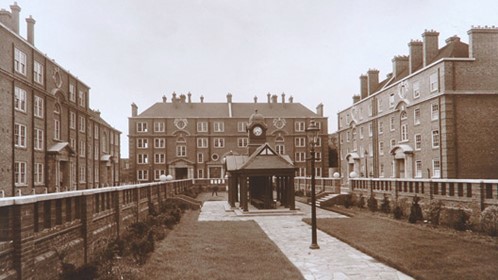The Hammersmith estate, which opened in 1926, covers almost six acres of land. There are records going back to 1793 of the land being used for property. Peabody bought the site from a convent at a cost of £38,438. The nuns' burial ground is now a sunken garden at the centre of the estate.
The whole estate was designed by Victor Wilkins who was Peabody's architect from 1910 to 1948. The buildings cost £250,000 to build and consisted of 284 flats in 32 blocks and 34 cottages. There was also a house for the Superintendent, as estate managers were called at that time. There were pram sheds, a coal store and a purpose-built laundry block with drying rooms. It was the last Peabody estate to be built with a separate bathhouse, and a series of photographs taken in 1927 show how these buildings looked.
The Hammersmith estate suffered badly during the Second World War, taking several direct hits from bombs and shells. In December 1940, 12 tenants were killed and 13 more in August 1944.
Post-war improvements provided each dwelling with a bathroom, and the bathhouse was converted to form accommodation for elderly people. In 1992 the whole estate was designated a conservation area.

Got a question about our archive – or have a story to tell?
Please email: history@peabody.org.uk
Please include a postal address or telephone number so that we can reply to you.
